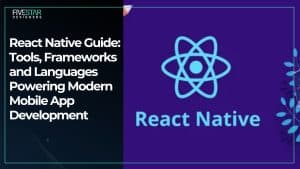Think about the websites you use every day, your favourite shop, your school portal, or a video app. Each one works smoothly because three invisible parts team up behind the screen: the frontend, the back-end, and the database.
The frontend is what you see and click. The back-end handles the brainwork. And the database keeps all the data safe. Together, they make the internet feel alive.
Let’s get into web tech explained in simple words that make sense for everyone.
The Foundation of Web Development: Frontend, Back-End & Databases
Every website or app runs on three layers that connect like puzzle pieces:
- Frontend: What users see and interact with.
- Back-end: Handles the logic, data, and background work.
- Database: Stores all your info safely.
Understanding this foundation helps both web developers and business owners make smart tech choices.
Frontend Development: The User’s Window into the Web
What Is the Frontend?
The frontend is the face of any website. It’s made using HTML, CSS, and JavaScript. These tools control layout, colour, and design. A good frontend makes a site fast, clear, and easy to use.
Responsive design matters too. Your website should look right whether someone’s on a phone, tablet, or laptop. Accessibility is also key, everyone deserves an easy experience online.
Popular Frontend Frameworks
Developers use tools like React, Vue, and Angular to build faster and smarter. These frontend frameworks save time and make it easier to keep sites updated.
Frontend vs Back-End: The Key Differences
When comparing front-end vs back-end, think of a restaurant. The frontend is the dining area, what customers see. The back-end is the kitchen, where the cooking happens. They’re different, but both are essential for the full meal.
Back-End Development: Powering the Web Behind the Scenes
What Does the Back-End Do?
The back-end is the part users don’t see. It handles requests, sends data, and connects to servers. When you log in, buy something, or post a photo, that’s back-end work.
Backend Technologies and Languages
There are many backend technologies that power modern websites, like Node.js, Python (Django, Flask), PHP, Ruby on Rails, and Java (Spring). Each has its strengths. Python is simple, Node.js is fast, and Java handles big projects well.
Backend vs Frontend Frameworks
Backend vs frontend frameworks work hand in hand. The back-end processes your data, while the frontend shows it. A popular full-stack combo is React with Node.js, which builds powerful and flexible web apps.
Databases: The Heart of Data Storage and Access
Why Databases Matter
Every website needs a safe place to store data, that’s where databases come in. They hold everything from usernames to product details.
Common Database Types for Web
There are several database types for web projects:
- Relational: MySQL, PostgreSQL (good for structured data).
- NoSQL: MongoDB, Firebase (great for flexible data).
- In-memory: Redis (used for fast temporary storage).
Each has pros and cons, depending on what your project needs.
Managing Data Efficiently
Developers use CRUD, Create, Read, Update, Delete, to manage data. Security, speed, and backup systems make sure data stays safe and easy to find.
Web Architecture Explained: How Everything Connects
Now let’s look at web architecture explained, how all parts talk to each other.
- The frontend sends a request (like “show my account”).
- The back-end receives it and checks the database.
- The database returns the data, and the frontend shows it.
Modern web architecture also includes caching, APIs, and load balancing to keep sites fast and stable even when traffic is high.
The Complete Web Development Stack
What Is a Web Development Stack?
A web development stack is the mix of tools and frameworks used to build a website. Each layer, frontend, back-end, and database, has its role.
Full Stack Web Technologies Overview
Full-stack web technologies combine both frontend and backend. Common examples are:
- MERN: MongoDB, Express, React, Node.js.
- MEAN: MongoDB, Express, Angular, Node.js.
- LAMP: Linux, Apache, MySQL, PHP.
Being a full-stack developer means you can work on both sides of the web, the look and the logic.
Choosing the Right Tech for Your Project
Choosing the right web development stack depends on your goals.
Here’s what to consider:
- Scalability: Can it handle growth?
- Budget: Does it fit your cost plan?
- Skills: Does your team know the tools?
Avoid picking fancy tools you don’t need. The best choice is the one that fits your project’s size and purpose.
Future Trends in Web Development
Web tech never stops growing. New trends include:
- Serverless computing: No need to manage servers manually.
- Headless CMS: Easy content updates.
- AI tools: Helping build smarter web systems.
- Low-code/no-code: Letting anyone create basic apps quickly.
The future of full-stack web technologies will focus on speed, automation, and easy scaling.
Why Businesses Trust 5StarDesigners.UK
5StarDesigners.UK builds websites that look great and perform even better. The team covers everything, design, frontend and back-end development, and database integration.
They work with modern stacks and frameworks to make your online presence strong and user-friendly.
Understanding Web Tech from Front to Back
Now you know how the frontend, back-end, and database all connect. Understanding web tech explained helps you see how websites truly work.
Every strong site starts with a smart web development stack, one that balances creativity, speed, and structure. Whether you’re a beginner or a business owner, knowing this gives you the power to build better online experiences.
Want to grow your online business?
Partner with 5StarDesigners.UK for smart, scalable, and reliable web development.
Contact us today to bring your idea to life.
FAQs
What is the main difference between front-end and vs back-end in web development?
The front end handles what users see and click, while the back end manages data, logic, and server processes behind the scenes.
Which backend technologies are best for scalable web applications?
Node.js, Python (Django/Flask), and Java (Spring) are popular backend technologies for building fast, secure, and scalable web apps.
How do full-stack web technologies improve modern web architecture?
Full-stack web technologies link the frontend, back-end, and databases, making web architecture more efficient, flexible, and easier to maintain.



